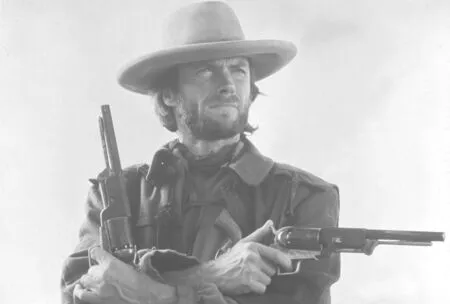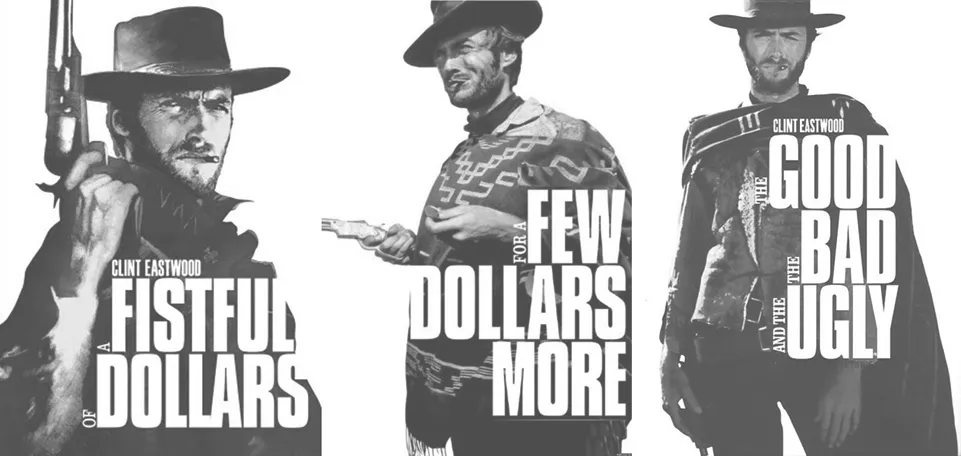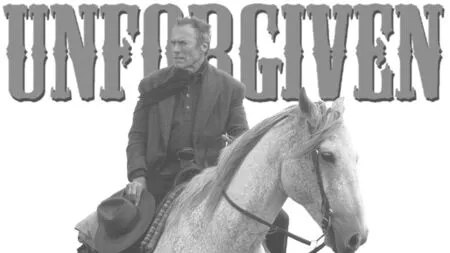Clint Eastwood History—Rise to Fame克林特·伊斯特伍德的“星”路历程
2018-04-02杜磊审订肖维青
译/杜磊 审订/肖维青
像一切有成就的伟人一样,伊斯特伍德的人生也历经沉浮,其间有一点运气,大部分靠的是拼搏。他的命运提醒着人们,一个人如果能找对自己在这个世界上的位置,就能干出一番成就。世上就有这么一个人,天生就该演西部片里的反派,做西部片的导演。伊斯特伍德就是那个集演员与导演于一身的人,我们很幸运,因为正是他给我们带来了那么多经典西部电影。
早年岁月
小克林特·伊斯特伍德出生于1930年5月31日,父亲是大克林特·伊斯特伍德,母亲是玛格丽特·露丝·伊斯特伍德。由于父亲工作的缘故,他们家屡次搬迁,但是克林特得以在加利福尼亚州的皮德蒙特度过了绝大部分童年时光。他就读于奥克兰技术高中。整个高中期间,各种各样的杂活儿他都干过,包括救生员、伐木工人、森林消防队员和加油站服务员。1951年,他应征入伍,参加了美国陆军,在加利福尼亚奥德堡担任游泳教练。有人说他当时为了不被送去朝鲜战场,竟和某个奥德堡官员的千金谈了一场恋爱,但此谣传未经证实。以前,军人搭乘军用飞机请假回家是件稀松平常的事。可正是这样一次飞行让伊斯特伍德险些送了命。当时,他搭乘一架二战中服役过的道格拉斯“天袭者”号,那架飞机燃料耗尽,最后在加利福尼亚雷伊斯角附近坠海。落水后,他和飞行员不得不在鲨鱼出没的水域里足足游了3英里才安全到岸,熟悉水性这个本领帮了他大忙。伊斯特伍德后来说,当时他根本不知道这片水域会有鲨鱼出没,如果当时清楚的话,他很可能就游不到岸了。但是,我们很高兴他成功了!在服役期间,伊斯特伍德结识了演员戴维·詹森和马丁·米尔纳,两人让他萌发了去好莱坞闯荡一番的念头。就这样,1954年,他结束了军旅生涯,只身赶赴好莱坞。到了那里之后,他只找到了一点点机会,如在电影《狼蛛》和《造物复仇》这样的片子里跑跑龙套。那些年,他做演员的日子过得很苦,星运暗淡,竟一度潦倒到为富人去山上挖游泳池的地步。直到1958年,在当时颇受欢迎的西部系列剧《皮鞭》中,他得到了扮演罗迪·耶茨这个角色的机会,人生这才有了第一次大转机。
所以我们就开始游了。当时已经是十月末十一月初了,水冷得刺骨。多年以后,我才知道这个区域是个大白鲨的繁殖地,但是我很高兴当时并不清楚,要不然,我可能早就死在那里了。——克林特·伊斯特伍德
《皮鞭》
据称,他是去好莱坞的哥伦比亚广播公司拜访一位朋友时获得的这个角色。一位工作室经理看中了他,因为他有着一副“牛仔样儿”。伊斯特伍德当时的片酬是750美元一集。由于此片在60年代初风靡一时,克林特·伊斯特伍德的人气也随之飙升,不久,他就因扮演年轻鲁莽的罗迪·耶茨这一角色而在全美家喻户晓。然而,此时的伊斯特伍德对这个角色却感到不甚舒服,因为他觉得自己的气质更适合演一个年长有阅历的角色。这部戏他演了8季。拍摄最后一季之前,埃里克·弗莱明辞演了,他即成为此剧的领衔主演,身价也暴涨到11.9万美元一集。《皮鞭》也是伊斯特伍德职业生涯工作时长最长的几部戏之一,甚至一天达12个小时。这在他后来开始执导之后发生了巨大转变。大家都知道他拍摄起来时间非常紧凑,往往拍一两次就完成了,午饭后大家就散场回家。在拍摄《皮鞭》的时候,伊斯特伍德就已经开始对导演这份工作跃跃欲试。他拍了几部预告片,甚至试图说服制片人让他来导演其中一集,虽然最后没能如愿。正当他拍《皮鞭》热火朝天的时候,又有人向他伸出了橄榄枝。一个叫赛尔乔·莱昂内的家伙在西班牙拍西部片,正好缺一个牛仔。包括亨利·方达、查尔斯·布朗森和詹姆斯·柯伯恩在内的一些好莱坞演员都不愿意接手这个角色,最后他在理查德·哈里森的推荐下找到了伊斯特伍德。我们现在都知道了,这部片子就叫《荒野大镖客》,它开启了克林特·伊斯特伍德一段伟大的“星运”之程。
《皮鞭》这部戏中的主角是个老好人,不管是对老妇还是狗都是一副“温唇脉脉”的样子,这种“白帽子”形象,我已经提不起任何兴趣来演了。那时候,我下定决心要演个反派来试试。——克林特·伊斯特伍德
“镖客”三部曲
《荒野大镖客》是三部曲里的第一部,这三部曲既可以定义伊斯特伍德的演艺生涯,又可以为西部类型片树立典范。赛尔乔·莱昂内一心想重塑西部片,一改往日西部片故事情节雷同、毫无新意的面貌。他想在画面上添加一些全新的元素,风格粗犷但却真实可信。结果他成就了这个“无名氏”,一个伊斯特伍德一度苦苦寻觅而不得的反派角色。不久以后,人人都看出来了,让伊斯特伍德来扮演这个角色简直堪称完美。他的男子气概就摆在那儿,一言不发就吸引了众多西部片拥趸,一夜之间,几乎每个人都想变成他的样子。后来的那部《黄昏双镖客》也一样大获成功,但是,三部曲里只有第三部大结局《黄金三镖客》才算得上真正经典。该片不仅成为西部片的经典,还成为电影制作的艺术典范。该片的场景、角色、服装造型(特别是克林特·伊斯特伍德的庞乔斗篷),都成为我们沿用至今的电影文化坐标。此片成为狂野西部片的灵魂之作,让西部片这把火熊熊燃烧了好几十年。
“镖客”三部曲的故事不同于其他西部片,影片的场面和风格在当时稍显不同。我认为任何一部都和约翰·韦恩1956年的《搜索者》那样的经典故事片不一样。三部曲的手法更像是一种剪影式、连载式的,通过一系列故事来展现中心人物。——克林特·伊斯特伍德
演而优则导
直到1967年,“镖客”三部曲才在美国本土上映。虽然评论界不叫好,但是这一系列电影却出乎意料地叫座,也捧红了克林特·伊斯特伍德。翌年,伊斯特伍德主演了另一部西部片《独行侠歼虎屠龙》,该片是美国制作,也一样大获成功。与此同时,他也开始尝试拓宽戏路,在保持自己独特表演风格的基础上转而出演一些其他的类型片。他主演了一部库根拍摄的带有西部片元素的侦探片《独行铁金刚》,以及一部二战电影《血染雪山堡》。此时,伊斯特伍德为了实现导演梦,已经创立了自己的电影制作公司Malpaso。这家公司是伊斯特伍德后来职业生涯的中心,后期他的绝大部分电影都是由这家公司出品的。1971年, 他执导了他的第一部电影《迷雾追魂》, 一部心理惊悚片,讲述了一个电台DJ(伊斯特伍德扮演)被女粉丝跟踪的故事。同样在1971年,克林特·伊斯特伍德还塑造了“肮脏的哈里”这个标志性角色。伊斯特伍德迅速成为好莱坞的大牌影星。这一时期他的作品极为丰富,但却一直没有中断经典西部片的拍摄:《烈女与镖客》(1970)、《猛龙煞星》(1972)以及他第一次执导的西部片——《荒野浪子》(1973)。到70年代末,他又拍了《不法之徒迈·韦尔斯》(1976),该片根据福里斯特·卡特的小说《去了得克萨斯》改编。据称,是伯特·雷诺兹把这个机会让给伊斯特伍德的。该片获得广泛认可,伊斯特伍德认为该片是他职业生涯中的亮点之一。此后将近十年的时间,伊斯特伍德都没有再拍过任何一部西部片。直到1985年,他才通过《苍白骑士》重返西部片,一举创下80年代西部片票房最高纪录。1992年,伊斯特伍德拍摄了一部在评论界颇有口碑的《不可饶恕》,并以此片作为告别西部片生涯的谢幕之作。此片被认为是电影史上水平最高、最地道的西部片之一,很多人甚至认为此片超越了“镖客”三部曲。伊斯特伍德曾说过,四五十年代浪漫风格的西部片很棒,但他想在银幕上呈现的是真真切切漫天黄沙的西部世界。对于再拍一部西部片,伊斯特伍德尚不置可否,但他说过,只要他活着就会拍电影,所以这事儿还有希望!
每个人都问我为什么你不再拍一部西部片了,好吧,这件事说说简单,做起来就难了。因为如果缺乏素材(故事),故事无趣,那么除了复制自己或者模仿他人,整个电影毫无意义。——克林特·伊斯特伍德 □
Like all great achievers Eastwood’s life have been ups and downs, a bit of luck and a lot of hard work. His life is a reminder of what a man can do if he finds his right place in the world. It just so happens that this man was made to be a badass western actor and director.Fortunately for us it all came together for Eastwood so that he was able to deliver the countless classics that we still enjoy to this day.
Early Years
Clinton “Clint” Eastwood Jr. was born on May 31st 1930 to parents Clinton Eastwood Sr. and Margaret Ruth Eastwood. The family moved around a lot due to Eastwood Sr.’s work, however, Clint spent most of his childhood in Piedmont, California. He attended Oakland Technical High School and during his high school years he had different odd jobs in the local area including lifeguard, logger, forest firefighter and gas station attendant. In 1951 he was drafted into the US army and served as a swimming instructor at Fort Ord in California. Some say he avoided being sent to Korea by dating the daughter of one of the of ficers at Fort Ord but this rumor is unconfirmed. In those days it was normal for serving men to hitch a ride on the army planes when they were going home on leave. During one of such flights Eastwood’s life almost came to a horrific end when the plane he was on, a WWII Douglas Skyraider,ran out of fuel and crashed into the ocean near Point Reyes in California.His skills in the water came in handy as he and the pilot had to swim 3 miles through shark infested waters to reach the shore. Eastwood has later said that at the time he didn’t know that there were sharks in the area and that if he had known he probably wouldn’t have made it. We are glad he did though!In the army Eastwood made friends with actors David Janssen and Martin Millner who exposed him to the idea of moving to Hollywood which he did after ending his time in the military in 1954. In Hollywood he had a few minor roles in movies such as Tarantula and Revenge of the Creature. He had some rough years with not much luck as an actor and at one point he had to resort to digging swimming pools for the rich people in the hills. He got his first big break in 1958 when he landed the role as Rowdy Yates in the popular western series Rawhide.

So we went swimming. It was late October, November. Very cold water. I found out many years later that it was a white shark breeding ground, but I’m glad I didn’t know that at the time or I’d have just died. —Clint Eastwood
Rawhide
Allegedly he got the role when he went to visit a friend at CBS in Hollywood and a studio executive called him out because he had the “cowboy look”. Eastwood was hired for 750$ an episode. As the show’s popularity rose through the early sixties, so did Clint Eastwood’s and soon he was known far and wide in the US as the young and foolhardy Rowdy Yates. Eastwood,however, did not feel comfortable in this role as he felt his temperament was more fitted for an older and more experienced character. He stayed in the job for 8 seasons and even became the lead actor of the series when Eric Fleming quit before shooting the final season, skyrocketing Eastwood’s salary to 119,000$ pr. episode. Eastwood had some of the longest days of his career while working on Rawhide, up to twelve hours a day. This drastically changed when he himself started directing as he is known to run a tight shooting schedule. One or two shots and it’s done, everyone goes home after lunch.While shooting Rawhide, Eastwood already started tinkering with directing.He shot a few trailers for the show and even tried convincing the producers to let him direct an episode but to no avail.While he was still doing Rawhide, an offer came to Eastwood. A guy called Sergio Leone was making a western in Spain and he needed a cowboy. A bunch of Hollywood actors, including Henry Fonda, Charles Bronson and James Coburn, had declined the job before it was offered to Eastwood on recommendation of Richard Harrison. The movie was A Fistfull of Dollars and as we already know, this was the beginning of a great career for Clint Eastwood.
In Rawhide I did get awfully tired of playing the conventional white hat1西部片中,戴白帽子的是正面角色,戴黑帽子的是反派。. The hero who kisses old ladies and dogs and was kind to everybody. I decided it was time to be an anti hero. —Clint Eastwood
The Dollars Trilogy
A Fistful of Dollars was the first of three movies that would come to de fine both Eastwood’s acting career and the genre of western movies. Sergio Leone was looking to reinvent the genre which had become repetitive and unoriginal.He wanted to bring something new to the picture, something raw and violent yet believable. This became the Man With No Name, the anti hero character that Eastwood was searching for at the time. It would soon be apparent that Eastwood fit the role perfectly. His macho and non-verbal demeanor became a hit among western fans and suddenly everybody wanted to be like him. The follow up, For a Few Dollars More,was also a success but it was the third and final movie, The Good, the Bad and the Ugly, that really hit home. It became a classic not only of the genre but of the art form of movie making. The scenes,the characters, the costumes (particularly Clint Eastwood’s poncho), it all became cultural reference points that we still use to this day. It became the essence of the wild west and it revived the genre for many decades to come.
[The Dollars trilogy] were stories that hadn’t been used in other Westerns.They just had a look and a style that was a little different at the time. I don’t think any of them was a classic story like [John Wayne’s 1956] The Searchers or something like that. They were more fragmented, episodic, following the central character through various little episodes. —Clint Eastwood

Ensuing Success and Directing
The Dollars trilogy wasn’t shown in the United States until 1967. Despite its bad reviews it turned out to be a huge success that made Clint Eastwood a major star. The year after Eastwood starred in another western picture, this time the American produced Hang ’Em High, which was also a success. He also started experimenting with other genres while still sticking to his trademark acting style. He starred in Coogan’s Bluff, a detective story with western influences, and Where Eagles Dare, a WWII flick. By this time Eastwood had founded his own production company,Malpaso Productions, in order to realize his ambitions as a director. This company would be the center of activity for the rest of Eastwood’s career, producing the majority of his movies. In 1971 he directed his first movie, Play Misty For Me, a psychological thriller about a radio DJ (Eastwood) who gets stalked by a female fan. ’71 was also the year of birth of another iconic Clint Eastwood character, Dirty Harry. Eastwood was quickly becoming an institution in Hollywood. He had a lot on his plate in those days but he kept making classic westerns throughout this period. Two Mules for Sister Sara (1970), Joe Kidd(1972) and High Plains Drifter (1973),the first western directed by Eastwood himself. He did one more western in the 70’s, The Outlaw Josey Wales (1976).The movie was based on the novel Gone to Texas by Forrest Carter which Eastwood was allegedly given by Burt Reynolds. The movie was well received and Eastwood considers it one of the highlights of his career. After The Outlaw Josey Wales Eastwood didn’t make another western for almost a decade. In 1985 he returned to the genre with the movie Pale Rider which became the highest grossing western of the 80’s.In 1992 Eastwood put the final dot on his western career with the critically acclaimed Unforgiven. It is considered one of the best and most real westerns of all time and many even believe it to be even better than the classic Dollar trilogy. Eastwood has said that the romanticizing westerns of the 40’s and 50’s were great but he wanted to show the real gritty west and how he imagined it would really have been with this picture. On the topic of making another western, Eastwood has neither dismissed nor con firmed anything, however, he has said that he will continue making movies for as long as he lives so there is still hope!

Everyone says why don’t you do another western, well that’s easier said than done because if you don’t have the material [the story] and if people don’t write an interesting take on it then it doesn’t add up to anything except repeating yourself or imitating somebody else. —Clint Eastwood ■
